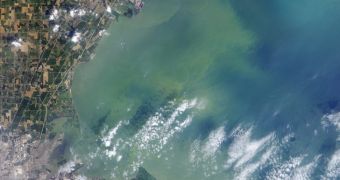Earlier this month, folks living in the city of Toledo in Ohio, US, were left without water for two consecutive days by a massive algal bloom in nearby Lake Erie.
The freshwater algae to blame for Toledo's ban on drinking tap water is dubbed Microcystis and is known to produce a toxin that can cause people to experience symptoms like numbness, dizziness, and vomiting.
Although the toxin has not yet killed any humans, folks who are exposed to it can sometimes develop severe liver damage. What's more, the toxin is known to be well capable to kill pets and other animals.
The ban was set in place shortly after specialists discovered that this toxin had worked its way into the water originating from the local Collins Park treatment plant, Live Science informs.
On August 1, NASA's Operational Land Imager on the Landsat 8 satellite snapped a photo of this algal bloom as seen from space. The image was released by NASA this past August 5 and is available next to this article.
As noticeable in the photo, such algal blooms look strikingly similar to cloud-like green masses when observed from above and tend to stand out against the blue of their surrounding waters.
The bloom that forced the city of Toledo to institute a ban on drinking tap water formed in Lake Erie's west end. Scientists say that it was caused by fertilizer runoff from local agricultural practices.

 14 DAY TRIAL //
14 DAY TRIAL //